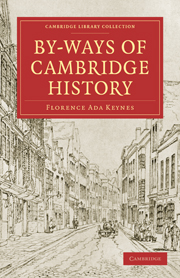Book contents
- Frontmatter
- PREFACE
- Contents
- ILLUSTRATIONS
- Introductory
- Chap. I The Guildhall and the Market Place
- Chap. II The Office of High Steward of the Borough of Cambridge
- Chap. III Cambridge Waits and Orlando Gibbons
- Chap. IV Barnwell Priory and the Old Abbey House
- Chap. V Why Oxford comes First. A Problem in Precedence
- Chap. VI Damaris Cudworth.—A Cambridge Woman of the Seventeenth Century
- Chap. VII A Town Plan for Cambridge in the Eighteenth Century
- Chap. VIII Mendicity House. Sidelights on Social Conditions in Cambridge in the Nineteenth Century
- Appendix: ‘Cambridge’ as a place-name
- Index
- Plate section
Chap. I - The Guildhall and the Market Place
Published online by Cambridge University Press: 07 September 2010
- Frontmatter
- PREFACE
- Contents
- ILLUSTRATIONS
- Introductory
- Chap. I The Guildhall and the Market Place
- Chap. II The Office of High Steward of the Borough of Cambridge
- Chap. III Cambridge Waits and Orlando Gibbons
- Chap. IV Barnwell Priory and the Old Abbey House
- Chap. V Why Oxford comes First. A Problem in Precedence
- Chap. VI Damaris Cudworth.—A Cambridge Woman of the Seventeenth Century
- Chap. VII A Town Plan for Cambridge in the Eighteenth Century
- Chap. VIII Mendicity House. Sidelights on Social Conditions in Cambridge in the Nineteenth Century
- Appendix: ‘Cambridge’ as a place-name
- Index
- Plate section
Summary
CAMBRIDGE has sometimes been described as being built like Rome on Seven Hills, but, if the theory of its dual origin is accepted, a theory for which there is much weight of expert opinion, another description may be suggested. Starting from the supposition that Mercians and East Anglians occupied sites separated only by a stream slightly to the north of the course of the river as it now flows under Magdalene Bridge, we get the interesting juxtaposition of two towns each built on its own hills in close proximity, but with little intercourse, since they were inhabited by hostile nationalities. As Arthur Gray said, the impact of the nationalities was at Cambridge.
The relative antiquity of the two settlements is uncertain, but that which was certainly the more important commercially, was centred on its four hills—Senate House Hill, Market Hill, Peas Hill, St Andrew's Hill—hillocks rather than hills, standing slightly above the surrounding marshy ground, levelled out of recognition now by the hand of time helped by the hand of man. Arthur Gray, writing in 1908, said:
For four centuries and longer Cambridge has been steadily raising the level of the grounds on the western side of the river. We have seen the process going on in recent years on Queens' Green and in Trinity Paddocks. It was going on in 1475, when the town covenanted with Queens' College to be allowed to deposit rubbish on the space between the College grove and the road leading to Newnham.
- Type
- Chapter
- Information
- By-Ways of Cambridge History , pp. 1 - 20Publisher: Cambridge University PressPrint publication year: 2009First published in: 1947



